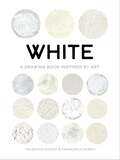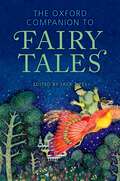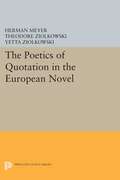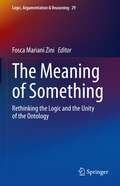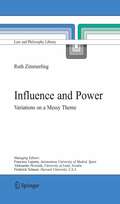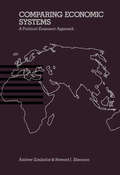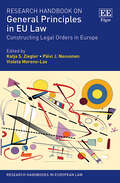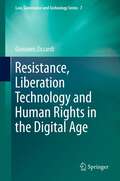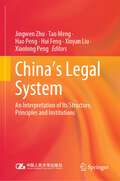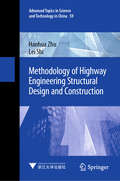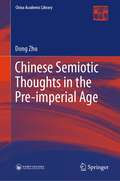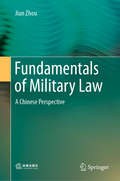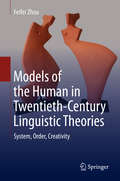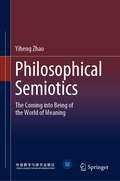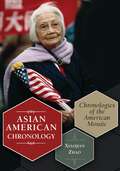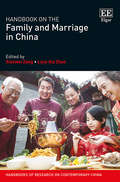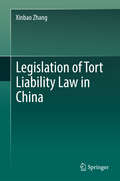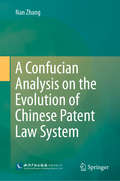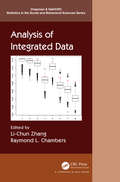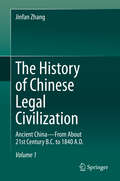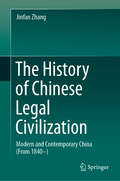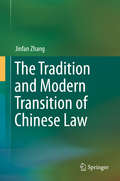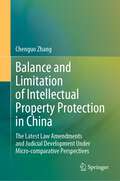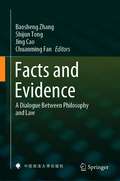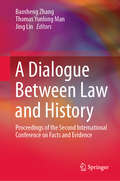- Table View
- List View
White: A Drawing Book Inspired by Art (True Color)
by Francesca Zoboli Valentina ZucchiMany people crave a creative outlet, but more often than not, don't know where to start. In White, Valentina Zucchi and Francesca Zoboli invite you to nurture your creativity and build your confidence by taking inspiration from works of art that celebrate the silent and tidy colour of white.White could be considered a non-colour, since it often suggests an absence of something. In fact, the reverse is true: white contains everything, even all the other colours. It has many shades, from chalk to snow white, and is found everywhere, from clouds to wedding dresses. Throughout the book, Valentina and Francesca provide creative and fun prompts – many based on famous works of art – which will encourage you to draw or paint on the pages using various techniques. Packed with inspiration from the world's most celebrated artists, including Paul Klee, Michelangelo, Claude Monet and more, you will discover the many shades of white and just some of the ways it can be used to convey meaning.White is a short course in unlocking your creative self – perfect for budding artists of all ages who are keen to try out different techniques and materials and begin their artistic journey.
The Oxford Companion to Fairy Tales (Oxford Companions)
by Jack ZipesIn over 1,000 entries, this acclaimed Companion covers all aspects of the Western fairy tale tradition, from medieval to modern, under the guidance of Professor Jack Zipes. It provides an authoritative reference source for this complex and captivating genre, exploring the tales themselves, the writers who wrote and reworked them, and the artists who illustrated them. It also covers numerous related topics such as the fairy tale and film, television, art, opera, ballet, the oral tradition, music, advertising, cartoons, fantasy literature, feminism, and stamps. First published in 2000, 130 new entries have been added to account for recent developments in the field, including J. K. Rowling and Suzanne Collins, and new articles on topics such as cognitive criticism and fairy tales, digital fairy tales, fairy tale blogs and websites, and pornography and fairy tales. The remaining entries have been revised and updated in consultation with expert contributors. This second edition contains beautifully designed feature articles highlighting countries with a strong fairy tale tradition, covering: Britain and Ireland, France, Germany, Italy, Japan, North America and Canada, Portugal, Scandinavian countries, Slavic and Baltic countries, and Spain. It also includes an informative and engaging introduction by the editor, which sets the subject in its historical and literary context. A detailed and updated bibliography provides information about background literature and further reading material. In addition, the A to Z entries are accompanied by over 60 beautiful and carefully selected black and white illustrations. Already renowned in its field, the second edition of this unique work is an essential companion for anyone interested in fairy tales in literature, film, and art; and for anyone who values the tradition of storytelling.
The Poetics Of Quotation In The European Novel (PDF)
by Yetta Ziolkowski Theodore Ziolkowski Herman MeyerThis work, which has had a pronounced impact on European literary scholarship since its publication in 1961, represents a new and imaginative approach to the history and poetics of the novel. Emil Staiger, dean of Swiss critics, describes Professor Meyer as " . . . a literary historian, who has a sense for the mixture of seriousness and playfulness in literature, who can talk seriously about the play and ironically about the seriousness . . . who has at his disposal the most thorough knowledge and never becomes ponderous . . . writes easily and gracefully. " The art of quoting is traced in Rabelais, Cervantes, and Sterne, followed by the development of these techniques in six major novelists from Wieland to Thomas Mann. Originally published in 1968. The Princeton Legacy Library uses the latest print-on-demand technology to again make available previously out-of-print books from the distinguished backlist of Princeton University Press. These editions preserve the original texts of these important books while presenting them in durable paperback and hardcover editions. The goal of the Princeton Legacy Library is to vastly increase access to the rich scholarly heritage found in the thousands of books published by Princeton University Press since its founding in 1905.
The Meaning of Something: Rethinking the Logic and the Unity of the Ontology (Logic, Argumentation & Reasoning #29)
by Fosca Mariani ZiniThis innovative volume investigates the meaning of ‘something’ in different recent philosophical traditions in order to rethink the logic and the unity of ontology, without forgetting to compare these views to earlier significative accounts in the history of philosophy. In fact, the revival of interest in “something” in the 19th and 20th centuries as well as in contemporary philosophy can easily be accounted for: it affords the possibility for asking the question: what is there? without engaging in predefined speculative assumptions The issue about “something” seems to avoid any naive approach to the question about what there is, so that it is treated in two main contemporary philosophical trends: “material ontology”, which aims at taking “inventory” of what there is, of everything that is; and “formal ontology”, which analyses the structural features of all there is, whatever it is. The volume advances cutting-edge debates on what is the first et the most general item in ontology, that is to say “something”, because the relevant features of the conceptual core of something are: non-nothingness, otherness. Something means that one being is different from others. The relationality belongs to something.: Therefore, the volume advances cutting-edge debates in phenomenology, analytic philosophy, formal and material ontology, traditional metaphysics.
Influence and Power: Variations on a Messy Theme (Law and Philosophy Library #68)
by Ruth ZimmerlingSome years ago, on request of the German Political Science Association (DVPW), an empirical investigation „On the state and the orientation of political science in the Federal Republic of Germany“ was conducted by Carl Böhret. Among other interesting 1 information, in the paper that was subsequently published the author presented the results of a survey among 254 political scientists in the Federal Republic on what they considered to be the sine qua non basic concepts of the discipline. In various respects, the data are remarkable. 2 On the one hand, the enormous diversity of the answers corroborates statistically what has long been known from experience, i. e. , the existence of an extremely wide variety of standpoints, perspectives, and approaches within the discipline. An interesting case in point is the concept of power. Somewhat surprisingly, ‘power’ was not the most frequently mentioned term. But, it did, of course, end up at the very top of the list, in third place behind ‘conflict’ and ‘interest’. What is noteworthy is that it gained this position by being named only 81 times, that is, by less than a third of the respondents. This is no insignificant detail. Certainly, to that minority of scholars whose conceptions of politics do include ‘power’ as an indispensable basic concept, the approaches of the vast majority of their colleagues for whom, as their answers in the survey reveal, ‘power’ does not play an eminent role must appear, in an 3 important sense, mistaken or perhaps even incomprehensible.
Comparing Economic Systems: A Political-Economic Approach
by Andrew Zimbalist Howard J. ShermanComparing Economic Systems: A Political-Economic Approach presents a political-economic approach to the analysis and comparison of different types of economic systems. Full, integrated political-economic case studies of several representative countries, including Japan, Sweden, and France, are given.This book consists of six parts and begins with an overview of some definitions of the main kinds of political and economic systems; theoretical arguments from various points of view about how political and economic systems relate to each other; and the criteria for evaluating different political-economic systems. The next section considers three essentially market capitalist systems: Japan, Sweden, and France. The Soviet Union, a centrally planned, allegedly socialist economy, is examined next. More specifically, Soviet development from 1917 to 1928 and from 1928 to the present is discussed. Central planning in developing countries such as China and Cuba is also explored. Finally, the theory of market socialism is analyzed, citing the cases of Hungary and Yugoslavia.This monograph will be of value to politicians, economists, and economic policymakers.
Research Handbook on General Principles in EU Law: Constructing Legal Orders in Europe (Research Handbooks in European Law series)
by K. ZieglerThis innovative Research Handbook explores judicial, scholarly, and theoretical approaches to general principles in the EU legal order against the backdrop of considerable uncertainty about the concept. It does so by analysing both a diverse range of general principles in discrete areas of EU law (‘zooming in’) and external, wider perspectives on the notion of a general principle of law from international law, comparative law, and legal theory (‘zooming out’).Rather than arguing for a single closed definition of what a general principle of law in the EU legal order must look like, this Research Handbook identifies conceptual, theoretical, and legal parameters within which the doctrine of general principles can be meaningfully discussed and contested in EU law. The different analytical layers built into this Research Handbook shed light on whether general principles are defined by the different contexts in which they apply; whether general principles are in practice leading to more coherence between different areas of EU law; and what challenges they create for the EU legal order. Chapters thus contribute to a more refined methodological and doctrinal understanding of general principles in the EU legal order.Opening up new spaces to critically reflect on the concept, role, significance, and limitations of general principles, the Research Handbook on General Principles in EU Law will be a key resource for scholars and students of European law, politics, and theory of integration and internationalisation.
Resistance, Liberation Technology and Human Rights in the Digital Age (Law, Governance and Technology Series #7)
by Giovanni ZiccardiThis book explains strategies, techniques, legal issues and the relationships between digital resistance activities, information warfare actions, liberation technology and human rights. It studies the concept of authority in the digital era and focuses in particular on the actions of so-called digital dissidents. Moving from the difference between hacking and computer crimes, the book explains concepts of hacktivism, the information war between states, a new form of politics (such as open data movements, radical transparency, crowd sourcing and “Twitter Revolutions”), and the hacking of political systems and of state technologies. The book focuses on the protection of human rights in countries with oppressive regimes.
China's Legal System: An Interpretation of Its Structure, Principles and Institutions (Understanding China)
by Jingwen Zhu Tao Meng Hao Peng Hui Feng Xinyan Liu Xiaolong PengThis book provides a systematic and detailed introduction to the formation process and current development of China's socialist legal system. The classification of the constitution and constitution-related laws, criminal law, civil and commercial law, administrative law, economic law, litigation and non-litigation procedural law, social law, and the specifics of each sector of law are explained, which is a good guide for understanding the framework of China's legal system and the study of each sector of jurisprudence.
Methodology of Highway Engineering Structural Design and Construction (Advanced Topics in Science and Technology in China #59)
by Hanhua Zhu Lei ShiThis book mainly studies the methodologies of structural design and construction for highway engineering, which are applicable to the overall control and the precise operation of engineering structures. It explores the method of comprehensive analysis, the simplification of complex problems, and the application of typical engineering tools. In turn, the book presents a number of innovative approaches, e.g. the coordinated control of structural deformation method, the theory of underground engineering balance and stability, and the soft soil foundation treatment of “bumping at the bridgehead.” These methodologies are then illustrated in typical cases and representative problems, explained from a practical standpoint. Examples in special settings are also discussed, e.g. highway construction in Tibet, and rebuilding after the Wenchuan earthquake. The book offers a valuable reference guide for all those whose work involves highway engineering design, construction, management, and scientific research.
Chinese Semiotic Thoughts in the Pre-imperial Age (China Academic Library)
by Dong ZhuThis book examines practices on the relationship between sign and meaning in the Pre-Imperial period of China from the semiotics perspective. Although the Chinese civilization did not develop a comprehensive semiotics system in that period, they are highly semiotic in many ways. The thinking and application of signs of Chinese people can be found in many classics, such as The Book of Changes, The Analects of Confucius, Tao De Jing and Zhuangzi. This book begins its study by re-examining the semiotic thoughts contained in The Book of Changes and inquiries into the thoughts of the major philosophers of different schools. It provides insights into the findings of these philosophers concerning the relationship between sign and meaning. In particular, it concentrates on how the prosperity of the various contending semiotic thoughts complemented each other in forming a sign system. In addition, the book also emphasizes the wholeness and associativity of observing things and studying relevant signs of Chinese people. As the first monograph in any language to systematically summarize Chinese semiotic thought in the Pre-Imperial period, this book helps promote understanding of the traditional Chinese culture and mindset.
Fundamentals of Military Law: A Chinese Perspective
by Jian ZhouThe book makes a comprehensive analysis of the basic principles and theories of military law, restructuring the theoretic framework of military law. It also puts forwards the new concepts of “core military law” and “international military law” for the first time in China, and even the world. The book could help legal scholars and lawyers, especially military lawyers and research fellows in military law, to have a new approach to study military law.
Models of the Human in Twentieth-Century Linguistic Theories: System, Order, Creativity
by Feifei ZhouThis book provides a refreshingly new perspective for investigating linguistic texts, which foregrounds models of the human. It presents a close reading of major linguistic theories in the twentieth century with a focus on three main themes: linguistic system and the individual speaker; social order; and linguistic creativity. The examination of these three fundamental themes concerning language and human nature, on the one hand, provides a fine-textured exposition on the implicit and explicit models of human nature endorsed by major theorists; on the other, it reveals the methodological dilemmas faced by linguistics. In light of the fact that the importance of considering posthumanist ideas is increasingly being underscored today, both within and outside linguistics, this focus on the human makes the book highly topical.
Philosophical Semiotics: The Coming into Being of the World of Meaning
by Yiheng ZhaoThis book attempts to solve the question whether semiotics is a methodology as is generally held and if the studies of meaning and the mind can shed light on a series of metaphysical issues, so that the edifice of semiotics could be erected on a philosophical ground. It proposes that a philosophical semiotics is, by necessity, a semiotic phenomenology about the construction of the “world of meaning” by signs, and any discussion about semiotics has to proceed around two core issues: meaning and the mind.This book particularly exemplifies the semiotic connections in various schools of traditional Chinese philosophies. In the “Pre-Imperial Age” (before BC 300), there emerged an abundance of semiotic thinking in China, from Yijing the first sign system that aims to explain everything in the world, to the Namists’s subtle argument about the form of meaning, from the Yin-Yang/five elements of the Han, to the “Things are non-existent while mind is non-non-existent” principle of the Vijñāptimātratāsiddhi School of Buddhism in the Tang, and from the Sudden Revelation of Chan Buddhism to the “Nothing outside the mind” endorsed by the Mindist Confucianism in the Ming. The mighty trend of philosophical heritage provides rich food to our understanding of the form of meaning.
Asian American Chronology: Chronologies of the American Mosaic (Non-ser.)
by Xiaojian ZhaoKey moments in Asian American history come alive in this concise and accessible chronology.Understanding the history of Asians in America is key to understanding the development of America itself. Asian American Chronology: Chronologies of the American Mosaic presents the most influential events in Asian American history—as well as key moments that have remained under the historical radar. This in-depth record covers events from the 18th century to the present day, including the 2008 Olympic Games in Beijing. Entries, organized chronologically by category, allow readers to trace the development of Asian peoples and culture in the United States over time, including the role of Chinese labor in building railroads, the importation of Filipino slaves, labor strikes and civil rights issues, Japanese-American internment, women's roles, literature, music, politics, and increased immigration in the mid-20th century. In addition to these broad topics, the book also treats individual events from the Rock Springs Massacre to the Gold Rush to the current prevalence of Japanese players in Major League Baseball.
Handbook on the Family and Marriage in China (Handbooks of Research on Contemporary China series)
by Lucy X. Zhao Xiaowei ZangThis Handbook advances research on the family and marriage in China by providing readers with a multidisciplinary and multifaceted coverage of major issues in one single volume. It addresses the major conceptual, theoretical and methodological issues of marriage and family in China and offers critical reflections on both the history and likely progression of the field. By examining the traditional ideas of marriage and family in China against new concepts, state policy changes and market reforms, the Handbook exposes the impact these changes are having on familial structures, traditional institutions and marital ideals. The eminent contributors include established scholars and emerging stars in this area of research, ranging from Australia, China, Canada, Europe, Hong Kong, Taiwan, the UK and the US. Working as a comprehensive and convenient reference for future research, this Handbook provides an extensive overview of the key issues in the field. An excellent reference tool for researchers and students of sociology, anthropology, public policy, family studies and China studies, this Handbook provides the knowledge for further research to flourish.
Legislation of Tort Liability Law in China
by Xinbao ZhangThis book studies the fundamental conflicts between the protections on the legal rights and interests of victims and the freedom of infringers to act first. It is divided into four parts, the first of which explores the relevant legal methodology in order to provide possible solutions to difficult problems in Chinese tort liability law. Secondly, it puts forward a range of suggestions on how to resolve key issues in China’s torts liability law, including the general provisions; the provisions concerning the fault principle; the provisions of the non-fault principle; the special liability relation; damages; and defenses and related issues. Thirdly, the book addresses major institutional issues, including: the theory of consensus force; joint infringements; and operators’ duty of care; as well as several key relations: between the right to claim insurance compensation and the right to claim compensation for personal injury; between the right to claim tort liability and the right to exercise property rights; and between the right to claim tort liability and the right to reject unjust enrichment. Further aspects in this section include compensation for death; mental damages; pure economic loss and compensation; punitive compensation; and compensation for road traffic accidents. Lastly, the book explores special issues in tort liability law, e.g. the infringement of media rights, and the specific tort liability in various administrative laws and regulations.
A Confucian Analysis on the Evolution of Chinese Patent Law System
by Nan ZhangThis book comprehensively discusses the main features of the Chinese patent law system, which not only legally ‘transplants’ international treaties into the Chinese context, but also maintains China’s legal culture and promotes domestic economic growth. This is the basis for encouraging creativity and improving patent law protection in China. The book approaches the evolution of the Chinese patent system through the ancient Chinese philosopher Confucius’s classic principle, offering readers a fresh new way to understand and analyze Chinese patent law reforms, while also outlining how Confucian insights could be used to improve the enforcement of patent law and overall intellectual property protection awareness in China. It examines ancient Chinese innovation history, explores intellectual property from a Confucian perspective, and discusses the roots of Chinese patent law, as well as the past three amendments and the trends in the ongoing fourth amendment. In addition to helping readers grasp the mentality behind the Chinese approach to patent law and patent protection, the book provides an alternative research methodology and philosophical approach by demonstrating Confucian analysis, which provides a more dynamic way to justify intellectual property in the academic world. Lastly, it suggests future strategies for local industries in the legal, cultural and sociological sectors in China, which provide benefits for domestic and overseas patent holders alike. The book offers a valuable asset for graduate students and researchers on China and intellectual property law, as well as general readers interested in Asian culture and the philosophy of law.
Analysis of Integrated Data (Chapman & Hall/CRC Statistics in the Social and Behavioral Sciences)
by Li-Chun Zhang Raymond L. ChambersThe advent of "Big Data" has brought with it a rapid diversification of data sources, requiring analysis that accounts for the fact that these data have often been generated and recorded for different reasons. Data integration involves combining data residing in different sources to enable statistical inference, or to generate new statistical data for purposes that cannot be served by each source on its own. This can yield significant gains for scientific as well as commercial investigations. However, valid analysis of such data should allow for the additional uncertainty due to entity ambiguity, whenever it is not possible to state with certainty that the integrated source is the target population of interest. Analysis of Integrated Data aims to provide a solid theoretical basis for this statistical analysis in three generic settings of entity ambiguity: statistical analysis of linked datasets that may contain linkage errors; datasets created by a data fusion process, where joint statistical information is simulated using the information in marginal data from non-overlapping sources; and estimation of target population size when target units are either partially or erroneously covered in each source. Covers a range of topics under an overarching perspective of data integration. Focuses on statistical uncertainty and inference issues arising from entity ambiguity. Features state of the art methods for analysis of integrated data. Identifies the important themes that will define future research and teaching in the statistical analysis of integrated data. Analysis of Integrated Data is aimed primarily at researchers and methodologists interested in statistical methods for data from multiple sources, with a focus on data analysts in the social sciences, and in the public and private sectors.
The History of Chinese Legal Civilization: Ancient China—From About 21st Century B.C. to 1840 A.D.
by Jinfan ZhangThis book, based on the theory of Marxism-Leninism, aims to study the essence, content and features of various legal systems in China in different historical periods, as well as the rules of the development of Chinese legal system. It effectively combines classic and historical analysis to probe the historical facts and elaborate the historical role of the legal system, revealing both the general and the specific rules of the development of the Chinese legal system on the basis of the existing relevant researches. The subject matter is of abundant theoretical and practical significance, as it enriches Marxist legal studies, deepens the readers’ understanding of Chinese legal civilization and offers guiding principles for the creation of socialist legal systems with Chinese characteristics. The chapters are structured chronologically, ranging from the Xia and Shang Dynasties, the Western Zhou Dynasty, the Spring and Autumn Period, the Han Dynasty, the South and North Dynasties, the Sui and Tang Dynasties, the Song Dynasty to the Ming and Qing Dynasties when Chinese legal system took on its final form. The chapters are compiled according to legislation, administrative law, criminal law and judicial system. Besides, the Chinese legal civilization after the Revolution of 1911 led by Sun Yat-sen is also addressed.
The History of Chinese Legal Civilization: Modern and Contemporary China (From 1840–)
by Jinfan ZhangThis book, based on the theory of Marxism-Leninism, aims to study the essence, content and features of various legal systems in China in different historical periods, as well as the rules of the development of Chinese legal systems. It effectively combines classic analysis and historical analysis to probe historical facts and elaborate the historical role of the legal system, revealing both the general and the specific rules of the development of China s legal system on the basis of the existing relevant research. The subject matter is of abundant theoretical and practical significance, as it enriches Marxist legal studies, deepens readers’ understanding of China s legal civilization and offers guiding principles for the creation of socialist legal systems with Chinese characteristics. It discusses the trends in thinking on the reconstruction of the legal system; changing laws; western legal culture; the legal system in the period of westernization, constitution and reform; preparation for constitutionalism; modification of the law during the late Qing Dynasty; criminal, civil and commercial legislation; and judicial reforms in the modern era as well as the various ups and downs and cases of malconduct after the founding of the People’s Republic of China.
The Tradition and Modern Transition of Chinese Law
by Jinfan ZhangThe book was first published in 1997, and was awarded the first prize of scientific research by the Ministry of Justice during the ninth Five-Year Plan of China. In 2005, it was adopted the text book for the postgraduates of law majors. In 2009, it was awarded the second prize of the best books on law in China. The book discusses from different aspects the long legal tradition in China, and it not only helps us to have a further understanding of Chinese legal system but also combines theories and practice and illustrate the modern legal transition which probes the history of Chinese legal system.As is known to us all, China is a country with a long legal history, which can be traced back to more than three thousand year ago. So the legal tradition of China has been passed down from generation to generation without any interruptions. This feature is peculiar to Chinese legal history which is beyond all comparison with that of other countries such as ancient Egypt, ancient India, ancient Babylon and ancient Persia. Through the study of Chinese legal history we can have a deeper understanding of the histories, features, origins and the transition of Chinese legal tradition. The Chinese legal tradition originated from China, and it is the embodiment of the wisdom and creativity of Chinese civilization. The great many books, researching materials, legal constitutions, archives, files and records of different dynasties in China have provided us with rare, complete and systematic materials to research. The book has a complete, systematic and detailed research on Chinese legal tradition and its transition and it gives people a correct recognition of the process of the perfection of laws during its development and its position as well as its value in the social progress in order to grasp its regular patterns. It also has showed us the most valuable part and core of Chinese legal Tradition and it is a summary of Chinese legal tradition and its transition from different perspectives, different angles and different levels. From the book, we can see that the ancient Chinese Legal Culture had once shocked the world and exerted great influence on the civilization of the world legal system, especially the legal systems in Asian countries. The book also has discussed the reestablishment of law in the late Qing Dynasty and the beginning of the Chinese law’s transition to modernity.In a word, the book has not only combined the legal system and the legal culture together, but also integrated the important historical figures and events ingeniously and it is a valuable and readable book with authenticity.
Balance and Limitation of Intellectual Property Protection in China: The Latest Law Amendments and Judicial Development Under Micro-comparative Perspectives
by Chenguo ZhangThe book focuses the openness of Chinese copyright law and patent law, namely the right limitation and exception rules (as the IP-internal balancing mechanism) and the right enforcement and protection (as the IP-external balancing mechanism). It examines the highlights of the 3rd and 4th amendments to the Chinese copyright law, patent law and the trademark law, addressing the most debated questions during these amendments. This book also takes a comparative approach to study the legislations and case laws in the USA, EU and China. The comparison covers the legislation, case decisions, which could offer useful clues for legislators to revise the current law, for judges to decide the cases about relevant topics and lay down their market plans. Moreover, this study also provides several recommendations for the right holders who are currently operating or planning to operate in China, regarding the de facto protection levels of their IP rights, the risks of right infringement and litigation costs as well as the trend of the goalsetting in their intellectual property strategy.
Facts and Evidence: A Dialogue Between Philosophy and Law
by Baosheng Zhang Shijun Tong Jing Cao Chuanming FanThis book presents an in-depth discussion on two concepts from the field of philosophy and law, in order to improve our understanding of the relation between “fact” and “evidence” in judicial process. Since fact-finding is a difficult task for judges, proof by evidence has been devised to help them access the truth. However, in the process of judicial fact-finding, there is always a gap between fact and truth. This book covers a wide range of topics, from reflections on the concept of “fact,” “evidence” and “fact-finding” in the field of philosophy and law to individual case studies. As such it is a useful reference resource on the continuing research on the judicial proof process for students and scholars.
A Dialogue Between Law and History: Proceedings of the Second International Conference on Facts and Evidence
by Baosheng Zhang Thomas Yunlong Man Jing LinThis book builds on the success of the First International Conference on Facts and Evidence: A Dialogue between Law and Philosophy (Shanghai, China, May 2016), which was co-hosted by the Collaborative Innovation Center of Judicial Civilization (CICJC) and East China Normal University. The Second International Conference on Facts and Evidence: A Dialogue between Law and History was jointly organized by the CICJC, the Institute of Evidence Law and Forensic Science (ELFS) at China University of Political Science and Law (CUPL), and Peking University School of Transnational Law (STL) in Shenzhen, China, on November 16–17, 2019. Historians, legal scholars and legal practitioners share the same interest in ascertaining the “truth” in their respective professional endeavors. It is generally recognized that any historical study without truthful narration of historical events is fiction and that any judicial trial without accurate fact-finding is a miscarriage of justice. In both historical research and the judicial process, practitioners are invariably called upon, before making any arguments, to prove the underlying facts using evidence, regardless of how the concept is defined or employed in different academic or practical contexts. Thus, historians and legal professionals have respectively developed theories and methodological tools to inform and explain the process of gathering evidentiary proof. When lawyers and judges reconsider the facts of cases, “questions of law” are actually a subset of “questions of fact,” and thus, the legal interpretation process also involves questions of “historical fact.” The book brings together more than twenty leading history and legal scholars from around the world to explore a range of issues concerning the role of facts as evidence in both disciplines. As such, the book is of enduring value to historians, legal scholars and everyone interested in truth-seeking.
